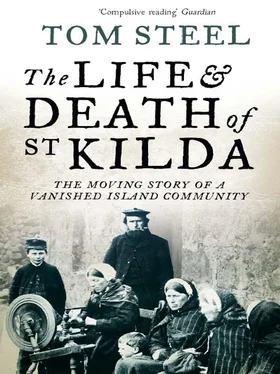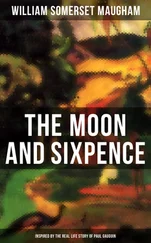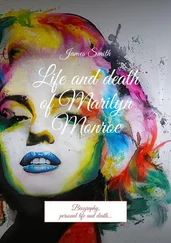Like many Celts, however, they were dreamers rather than men of action. They much preferred to talk and could, to the observer at least, always give better reasons for not doing something than they could acquiesce. Many writers took their lethargy to be laziness. ‘I fear’, wrote John MacDonald in 1822, ‘they cannot be exempted from the charge of almost habitual indolence. They are seldom wholly idle; but when they are at any work, one would think that they are more anxious to fill up than to occupy time.’ To the St Kildans, however, the pace of work was dictated by their needs. Time to them was an immaterial dimension divided more into seasons than into months and days. The men in particular saved their energies for the capture of sea birds and did little to help around the croft.
‘The men I always thought might have done more work,’ wrote the missionary’s wife in 1909, ‘although once properly started they worked well. I used to find fault with them for allowing the women to do all the work they themselves ought to have done. It was no uncommon thing to see the young men helping to rope the bags on to the women’s backs. Sheep, coal, or any burden was carried from the pier by the women as a rule – very occasionally the men. I thought it very funny on one of my visits to the village to see the wife digging the ground, preparatory to planting the potatoes, but the good man of the house was seated at the door sewing a Sunday gown for his wife.’ Life on Hirta was such that women were never allowed much leisure. Apart from the routine household chores, the women were responsible for bringing water, fuel, and provisions into the house. Every summer, knitting as they went, the women used to walk over two miles twice a day to milk the cows and ewes in Glean Mor. Whilst boys were soon taught the art of talking much and doing little, the girls were accustomed to carrying heavy weights on their backs from a very early age.
The morals of the St Kildan and his spouse, however, could not be faulted. Crime was virtually unknown on the island. In a society in which each and every member had to get along with his neighbour in order to survive, crime could not be tolerated. Moreover, there was a distinct lack of motive – each islander was the same in terms of both wealth and status as his fellow St Kildan. ‘I held, along with Mr McLellan and the Gaelic teacher,’ wrote John MacDonald in 1822, ‘a meeting, something like what might pass in St Kilda for a justice of peace court, in order to settle little differences that might exist among the people; and was pleased to find, much to their credit, none of any consequence, except one relating to a marriage.’ St Kilda was totally free from the ‘bend sinister’, the morality of the men being even more unimpeachable than that of the women. There was little drunkenness. When a St Kildan had whisky to drink, it was reserved for medicinal purposes, or put away in a cupboard to celebrate a marriage. ‘Their morals’, concluded the Reverend Macaulay in 1758, ‘are and must be purer than those of great and opulent societies, however much civilised.’
The islanders were intensively religious. Their fervour was in part induced by their physical situation. A sea-girt isle, rising almost perpendicularly from the sea, with nothing save the often fierce Atlantic in sight, St Kilda presented man with almost insurmountable odds. Under such conditions of geography and climate, Man became even more infinitesimal before the Infinite. The people took for their own a harsh, puritanical religion, which gave them a peace of mind and offered them, if not a future on this earth, at least a pattern which they could follow and a promise of a more certain life in the next world.
As contact with the mainland increased during the nineteenth century, the St Kildan character developed in some respects detrimental to the reputation of the people. ‘A St Kildan woman’, wrote Kearton in 1886, ‘always regards everybody with suspicion, and does not hurry over a purchase, thinking that she is being cheated.’ The islanders were a simple, honest people: the tourists were more sophisticated and from a society in which it was the common thing to seek to take advantage. The St Kildans were incapable of adapting to a more complex set of rules of behaviour and became introverted. Nor did they distinguish between tourists and those who came to their island to do genuine good. Doctors found themselves faced with resolution and stubbornness. ‘There is no need’, wrote Norman Heathcote in 1900 of the St Kildans, ‘for them to go through the form of saying that they are conscientious objectors. They simply refuse to allow their children to be operated on, and there is no more to be said.’
To the end, the St Kildans possessed a simplicity that was at once attractive, if infuriating. When Emily MacLeod, the sister of the then proprietor, told the St Kildans in 1877 that she like Queen Victoria was a plain old woman, she was sternly rebuked by the islanders, who informed her that she must not refer to Her Majesty in such a way, as the Bible said that subjects must honour their monarch. When a supply of cement was sent to St Kilda so that a proper aisle could be laid in the Church, the ‘bags of dust’ as the islanders called them were stacked outside the Church to await a time when the men could see their way to doing the job. The following summer a friend of the proprietor arrived to ask how the work had gone. The ‘bags of dust’, said the men, had by a miracle all turned into lumps of rock before they had got round to using them.
Whatever their faults, the St Kildans led an unenviable way of life. The provision of food was their major concern year in and year out. They were forced to make good use of everything that their poor island could offer them in the struggle for survival. Moreover, they lived in the knowledge that any part of the provisioning process could be disrupted at any time by weather and illness. Isolated from the rest of humanity, only the laird of Dunvegan was there to protect them from starvation.
Boys on St Kilda were taught to climb cliffs as soon as they were able. ‘The first thing to attract our notice’, wrote John Ross the schoolmaster of an August day he spent in a boat at the foot of the cliffs of Conachair, ‘was one of the men and his little boy on a rugged but fairly level piece of ground rather down near the sea. One end of the rope was tied round the father’s waist while the other was tied round the boy’s waist. Most probably, lest he being young, rash and inexperienced, might slip into the sea. There they were all alone then, killing away at a terrible rate, for the boy was collecting while the father kept shaking and twisting.
‘The man removing himself from the rope shouldered a burden of dead fulmars and made for a cutting in the rock, too narrow one would think for a dog, and too slippery for a goat. Along this he crawled on hands and knees. A single slip in the middle would have hurled him at least eighty feet sheer down into the sea. But he landed his burden safely and returned for the boy. The rope was tied as before, but only about a yard was left between them this time and that brave little fellow of only ten summers fearlessly followed his father and reached safety without a hitch. This is how the St Kildans train their young to the rocks and what a dangerous life it is.’
The St Kildans learnt how to climb from childhood. Most of them remember playing on the cliffs of Conachair when they were young and thinking nothing of it. They grew up to be short, stocky, agile men, natural climbers. The bone structure of their ankles differed from that of people born elsewhere. The ankle of a St Kildan male was practically half as thick again as that of a mainland person, and the toes were set further apart and almost prehensile.
Читать дальше












